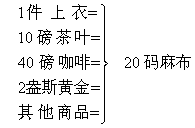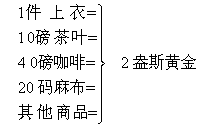货币
货币huobi
充当一般等价物的特殊商品。在世界各国的历史上有许多种商品充当过一般等价物。随着商品生产和商品交换的发展,一般等价物最终都固定在其自然属性最适宜充当货币的金、银身上,产生了货币。货币是价值形态发展的结果。
价值形态的发展经历了四个阶段。❶简单的、偶然的价值形态,它的等式是:20码麻布=1件上衣。在这个等式中,等式两端的商品处于不同的地位,起着不同的作用。等式左端的麻布,通过交换,使它的价值在上衣的商品体上相对地表现出来,是价值被表现的商品,处在相对价值形态的地位上。等式右端的上衣,用它自己的商品体表现了麻布的价值。它好象一面镜子,从它的身上,反映出另一种商品的价值,是处于等价形式的地位上,起着等价物的作用。在商品交换的这一阶段,一种商品只是偶然地成为另一种商品的等价物。
❷总和的或扩大的价值形态。它的等式是:20码麻布=1件上衣,或=10磅茶叶,或=40磅咖啡,或=2盎斯黄金,或=其他商品。这种价值形态反映了生产力和社会分工有了发展的条件下日益扩大的商品交换关系。在这个等式中,麻布在同其他商品相交换的关系中构成一系列的等式。麻布的价值可以通过一系列商品表现出来。
❸一般价值形态。它的等式是:

❹货币形态。它的等式是:

货币出现以后,各种具有不同使用价值的商品通过货币的媒介作用,实现全面的互相交换,这就解决了物物交换过程中所遇到的困难。同时,商品内在矛盾也以新的形式扩大化了,由商品与商品的对立,转化为商品与货币的对立。所有的商品生产者都要把自己的商品换成货币。商品生产者只有把他的商品换成货币,他的私人劳动才能转化成社会劳动。从价值形态的发展和货币的产生过程可以看到,货币不过是在商品交换过程中,从商品世界中游离出来,固定地充当一般等价物的商品。货币作为一般等价物,具有五个职能:价值尺度、流通手段、贮藏手段、支付手段、世界货币。前两个是货币的基本职能,其他职能是在基本职能的基础上派生出来的。
货币
货币
货币
充当一般等价物的特殊商品。在商品交换的长期发展过程中,自发地从商品世界中分离出来。历史上,牲畜、皮毛、贵金属等曾作过货币材料,最后逐渐固定在金银上。它同其他商品一样,具有使用价值和价值。执行价值尺度、流通手段、贮藏手段、支付手段和世界货币五种职能,前两种为基本职能。体现着商品生产者之间的社会关系。
货币
见“政治经济学”部分“货币”。
货币Money
固定地充当一般等价物的特殊商品。具有价值尺度、流通手段、贮藏手段、支付手段和世界货币五种职能。
殖民初期,加拿大地区流通欧洲各国的金银币。加拿大最早的纸币是1865年由新法兰西总督签发的“扑克”钞票,用以补充该地区流通的主要货币——法国银币和西班牙银币的不足。这种扑克牌无自身价值,其票面价值由殖民政府担保。“七年战争”期间,政府为了支付巨额战争费用,超量发行纸币,致使纸币价值得不到担保,引起恶性通货膨胀。英国征服新法兰西后引入英镑货币,以后的近一个世纪,英镑及其铺币先令、便士成为加拿大的正式官方货币。流通中的各种货币取得对英镑的兑换价值,如1西班牙元兑换5先令,即4元兑换1英镑。为了方便与英镑的兑换,甚至发行过票面为4元的西班牙元银行券。然而在当时流通的众多货币(有新斯科舍货币、美元、西班牙元、美国金币和英军的“军人券”)中英镑始终没能取得主导地位。
自治领建立前的20多年里,政府就已采取措施放弃英镑货币而采取一种近似美元体系的独立的十进制货币体系。1858年,加拿大省政府通过立法规定采用加元代替英镑进行政府结算,同时政府开始发行自己的加元货币,与蒙特利尔银行和其他银行发行的货币共同流通。自治领建立之初,大多数加拿大人以为,钱就是钱,不论华盛顿发行的、渥太华发行的还是某个银行发行的都一样。加拿大货币体系与美元体系尽管有诸多差异,但始终如影随形,没有完全分开。1870年,为对抗实际价值仅80分的1美元银币在加拿大市面的泛滥,自治领政府曾发行过25分的辅币。加元与美元的分道扬镳始于第一次世界大战后的高通货膨胀时期。1920年,加元与美元的兑换率跌至1:0.84,尔后迅速回升,并在20年代后期稳定在1:1的水平上。随着大萧条(1929年~1933年)的到来,加元与美元的兑换率再次跌至1:0.80,但先于经济迅速回升,在30年代中期高达1:1.04。1952年~1962年的10年间,加拿大实行浮动汇率,而美国仍维持固定汇率,随着美国大举投资加拿大,加元汇率时常高于美元。美元危机冲击了1962年的加拿大联邦大选,加元与美元的兑换率被固定在1:0.925的水平上。1970年,加元汇率恢复浮动,立即高于美元。但这一汇率的高居是虚假的,1976年魁北克人党大选的获胜引发了加元汇率的下跌,此后一直下跌,1986年4月跌至历史最低点1:0.69。后开始回升。
70年代,“过量货币引起通货膨胀”这一古老论断重新兴起,政府也试图以控制货币供给量来控制通货膨胀。货币供给量包括现金、银行存款、其他金融机构存款和某些短期票据,有时还包括信用卡。
加拿大货币体系与国际货币体系不可分割,是国际货币体系的一部分。在80年代前期,加拿大与国际货币体系共同经历了一场严重危机,危机通过许多国家的高通货膨胀甚至超通货膨胀、高利率、金银价格波动无常和第三世界的巨额债务等问题暴露出来。
货币
货币是在商品经济的发展过程中自发产生的,它是商品内在矛盾运动的必然产物。货币的本质是固定地起一般等价物作用的商品。它体现了商品经济条件下人们的相互关系。
货币出现以后,整个商品世界分成了两极:一极是各种各样的具体商品,它们分别代表不同的使用价值; 一极是货币,即专门起一般等价物作用的商品,它只代表商品的价值。在货币价值形式下,商品内部使用价值和价值的矛盾,就表现为商品和货币的矛盾。商品换成了货币,商品的使用价值和价值的矛盾就解决了。如果商品不能换成货币,商品使用价值和价值的矛盾就得不到解决。在这种情况下,商品的使用价值就不能发挥作用,价值也不能实现,生产商品的私人劳动也就得不到社会的承认。可见,货币出现以后,商品经济的矛盾更深化了。
货币的本质体现在它的职能上。货币的职能是随着商品经济的发展而逐渐完备起来的。在发达的商品经济中,货币具有以下五种职能。
1.价值尺度
货币作为衡量和计算一切商品价值量的尺度,就是价值尺度的职能。货币所以能够用来衡量一切商品的价值,是因为它本身也有价值;如果本身没有价值,就无法衡量别的商品的价值。正如可以衡量其他一切物品长度的尺子,其本身也必须具有一定的长度一样。
马克思说: “货币作为价值尺度,是商品内在的价值尺度即劳动时间的必然表现形式。”这就是说,商品价值并不是因为有了货币才可以被衡量的,而是由于商品价值就是凝结的人类劳动,所以它本身就可以由劳动时间来衡量。货币作为价值尺度不过是商品内在价值的外在表现。
货币充当价值尺度可以是观念上的,就是说要衡量某一商品价值的多少,并不需要把现实的货币摆在那里比较,只要写出或说出值多少货币就可以了。
商品价值的货币表现就是价格。但是,货币要计量和比较各种商品的价值,它本身也必须以固定的计量单位作为标准,如以白银作为货币,就需要把白银划作两、钱、分等计量单位。这种由统一规定的用以衡量货币本身的计量单位,就叫做价格标准(或称价格标度)。有了价格标准,货币才能更好地发挥价值尺度的作用,货币作为价格标准所起的作用和价值尺度是不同的。作为价值尺度,它是人类劳动的社会化身,用以衡量商品的价值,使之表现为价格;作为价格标准,是规定贵金属重量的技术标准,是用来衡量和计算货币金属本身的数量的。但二者又有密切联系,规定价格标准是为了使货币能够更准确地执行价值尺度的职能。
2.流通手段
货币作为买卖商品的手段来使用,就是流通手段的职能。货币作为流通手段,起着媒介商品交换的作用。以货币为媒介的商品交换就是商品流通。
在货币出现以前,商品交换采取以物易物的形式,在交换过程中,卖的过程同时就是买的过程,二者是结合在一起的。而在以货币为媒介的商品流通中,某人卖了之后,却不一定马上就买。卖掉商品的人可以握有货币而一时不购买商品,这就相应地会使另外的人卖不出去商品,于是卖和买就可能出现脱节现象。可见,在货币作为流通手段出现以后,就已经有了危机的可能性。当然这种可能性要变为现实性,需要商品经济发展到一定的高度。
货币作为流通手段,最初是以贵金属条块的形式出现的。但这种形状不一、重量不等、成色不同的贵金属条块,给交换的进行带来了不便,于是就逐渐产生了具有一定形状、重量、成色和标明额面价值的金属货币,这就是铸币。铸币一般是由国家铸造,作为法定的货币来流通。
铸币的长期流通,由于不断磨损而会使重量减轻,但这种不足值的货币仍可照常充当流通手段,因为作为商品交换媒介的货币,不断地从它的所有者手里流向别处。因此,商品所有者关心的是货币能否充当流通手段,而并不关心货币是否足值。铸币的实际价值和它所标明的价值的脱离,使贵金属货币由价值符号来代表成为可能,于是后来就出现了纸币。纸币是由国家发行的、强制流通的价值符号,它代表贵金属货币执行流通手段的职能。
3.贮藏手段
货币是一般等价物,谁有货币谁就可以任意购买各种商品,于是货币就成了社会财富的一般代表。货币的这种性质,引起了人们贮藏货币的欲望。货币退出流通而作为社会财富被人们贮藏起来,就是贮藏手段的职能。
货币作为贮藏手段,既不能是观念上的即想像中的货币,也不能是价值符号,而必须是金属货币。
贮藏货币可以调节货币的流通量,流通中需要的货币量减少时,多余的金属货币就会退出流通,贮藏起来;流通中需要的货币量增加时,贮藏的货币就会重新投入到商品流通中。在私有制商品经济中,货币贮藏的这种调节作用,是自发进行的。
4.支付手段
随着商品经济的发展,出现了赊账买卖,在赊购到期,以货币来偿还债款时,货币便执行支付手段的职能。货币作为支付手段,还可以用来支付租金、利息、工资和赋税等。
货币作为支付手段,可以使商品在缺乏现金的情况下得以流通,从而有利于商品经济的发展;而且由于有些债务可以互相抵消,不再需要以货币作为流通手段,这就可以节省流通中所需要的货币量。
同时,货币作为支付手段也扩大了商品经济的矛盾。在存在支付手段的条件下,许多商品生产者以赊账买卖的方式发生了债务关系,形成债务链。例如,甲欠乙的钱,乙欠丙的钱,丙欠丁的钱,如果其中任何一个人因故未能按期偿还债务,就会影响其他一系列人支付欠款,由此引起的连锁反应,会使许多商品生产者因缺乏货币而无法继续生产。
5.世界货币
货币越出一国的范围,在国际经济关系中充当一般等价物的作用,就是货币的世界货币职能。
铸币和纸币的制造和发行,都是由一定的国家政府机关负责和认可的。因而,作为世界货币就不能采取铸币和纸币的形式,而必须采取原来的贵金属条块的形式。在现实生活中,某个国家由于经济力量十分强大和某些特殊的历史原因,该国的铸币和纸币可以在一定时期在世界很大的范围内起着世界货币的作用,如第二次世界大战后的美元。
货币的世界货币职能,主要有以下几方面: (1)作为一般的支付手段,用来支付国际收支的差额; (2)作为一般的购买手段,用来购买外国的商品; (3)作为社会财富的代表,由一国转移到另一国,如支付战争赔款以及财产转移等。
货币的各种职能,都共同表现了货币作为一般等价物这一本质特征。在货币的五种职能中,价值尺度和流通手段是它的基本职能,货币一旦产生就同时具有了这两种职能,其他几种职能是随着商品经济的发展而逐渐产生的。
货币Currency
独立战争以后美国货币因大陆券发行量过大而贬值。汉密尔顿曾希望通过建立合众国银行来稳定货币,但这一希望未能实现。国家贸易存在逆差,黄金储备不足,因此政府不能发行金本位制钞票。硬币数量有限,面值不一,与外国硬币互相竞争。1834年国会规定金银价值比率约为1比16。1857年铸造了铜币和镍币,用以取代独立战争以后国会宣布为合法货币的西班牙硬币。州银行发行的钞票在企业贷款和金融投机方面与合众国银行发行的纸币互相竞争。对西部地区、运河和铁路的投资过大,加以颁布的一些法规收效不大,导致国家财政情况混乱,这种现象一直持续到内战。内战期间联邦政府发行的绿背纸币是国会试图通过发行信用券以稳定金融的第二次尝试。1879年以后,绿背纸币可以兑换,但一直流通至今。内战后,主张复本位的农民运动使银本位证券和国库债券分别根据布兰德—艾利森法和谢尔曼白银购买进入流通。这些证券同国家银行根据1863年法案发行的钞票互相竞争。19世纪末,在美国流通的货币有金票、贬值的银证券、绿背纸币、国家银行钞票以及各种各样的硬币,各种货币都具有各自的合法货币地位。1913年又增加了联邦储备券。1933年,国会授权发行联邦储备银行货币。大萧条时期的财政问题迫使美国对货币进行彻底改革。1934年制定的法案再次肯定银证券作为合法货币的地位,但金证券、联邦储备银行货币和国家银行钞票都停止流通。取消金本位制完全改变了美国通货中黄金的地位。1965年,美国流通的货币量近380亿美元。